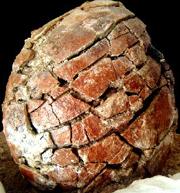Science News
Dinosaur Egg Heaters

Certain sauropods in Argentina didn’t need to sit on their eggs to keep them warm, they had heaters—natural heaters in geothermal vents.
Paleontologists mapped several egg clutches in the Sanagasta Valley in La Rioja province, northwestern Argentina last summer and found that certain dinosaurs returned again and again to the same nesting site. The reason seems to be the warm geothermal vents that existed there during the Gondwanic hydrothermic cycle—134 to 110 million years ago.
According to their paper, published June 29th in Nature Communications,
Sedimentary and geochemical analyses of 80 clutches and their large eggs with thick eggshells substantiate that the Sanagasta sauropods were specifically using the soil moisture and thermoradiance to incubate their eggs.
An article in Nature suggests that the eggs evolved to withstand such harsh conditions during incubation:
The team found that the eggs were large and thick-shelled when freshly laid, an adaptation that may have evolved to allow them to safely incubate in the acidic environment near geyser fountains.
The researchers have yet to determine the species of sauropods that the eggs belonged to, only noting that it belonged on the branch of neosauropods. According to the “Not Exactly Rocket Science” blog from Discover:
Each huge egg measured around 21 centimetres in diameter… They are so big and thick that they must have been laid by very large animal indeed, probably one of the giant sauropods. Unfortunately, no skeletons have actually been found so Grellet-Tinner and Fiorelli [the paleontologists] can’t tell us what species laid these eggs. Whatever they were, they clearly laid their eggs in the valley repeatedly and en masse, forming a long-lasting relationship with this special place.
Currently, only an endangered turkey found in Tonga, a type of megapode, has similar egg-laying behavior. They lay their eggs in volcanically heated burrows.
Image credit: Gerald Grellet-Tinner/Lucas Fiorelli